Are you looking to give your patio a fresh new look? Pressure washing might be the solution you are looking for.
In this article, we will explore the benefits of pressure washing a patio, the materials commonly used for patios, and when to consider pressure washing.
We will also provide a step-by-step guide on how to pressure wash your patio safely and efficiently, along with the equipment needed and post-wash maintenance tips.
Stay tuned to find out if pressure washing your patio is worth it!
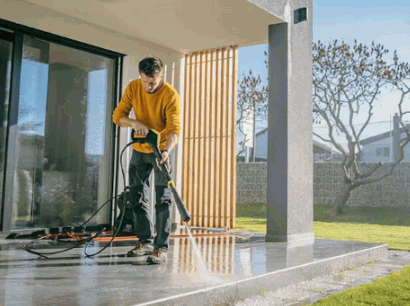
What is a Patio?
A patio is an outdoor space connected to a residence, often paved with materials such as concrete, stone, or wood, meant for outdoor activities and relaxation. Homeowners often use patios for entertaining guests, dining alfresco, or simply enjoying the outdoor environment.
Patio surfaces can be constructed using various materials such as brick, tile, gravel, or even composite decking, depending on the homeowner’s preferences. The choice of material not only affects the aesthetic appeal of the patio but also its durability and maintenance requirements.
For instance, wood patios exude a cozy and rustic charm but may require regular staining and sealing to withstand outdoor elements, while concrete patios offer durability but can be prone to cracking over time without proper care.
Find out more: Is It OK To Pressure Wash A Roof

What Materials Are Patios Made of?
Patios can be made of various materials such as wood, concrete, and stone, each offering unique aesthetics, durability, and maintenance requirements.
Wooden patios, while warm and inviting, need regular sealing to protect them from moisture and UV damage. Regularly sweeping and mopping them can prevent dirt buildup.
Concrete patios are durable but can stain easily. Stains should be tackled promptly using a mild detergent or specialized cleaner specifically designed for concrete surfaces to maintain their appearance.
Stone patios exude a natural elegance but require gentle cleaning to avoid damaging the surface. Using a pH-neutral cleaner and avoiding harsh chemicals is crucial for their longevity.
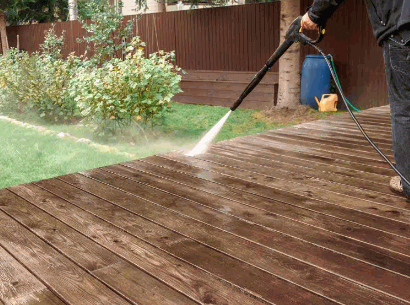
Why Pressure Wash a Patio?
Pressure washing a patio is essential to remove accumulated dirt, grime, stains, and algae, restoring its appearance and prolonging its lifespan.
Over time, patios can become a breeding ground for dirt, grime, and stubborn stains that not only deteriorate the appearance of the surface but also weaken its structural integrity. These build-ups can make the patio look dull and neglected, impacting the overall aesthetics of your outdoor space. Algae, especially in damp environments, can quickly spread and mar the beauty of the patio.
With regular pressure washing, you can efficiently eliminate these contaminants, unveiling a revitalized patio that enhances the charm of your home and boosts its curb appeal.
Benefits of Pressure Washing a Patio
Pressure washing a patio offers numerous benefits, including a clean and fresh appearance, saving time on manual cleaning, and extending the lifespan of patio items and surfaces.
By thoroughly cleaning the surfaces, pressure washing can eliminate built-up dirt, grime, and stains, transforming the patio into a vibrant space that enhances the overall look of the outdoor area. The convenience of pressure washing means that hours of manual scrubbing and cleaning are condensed into a fraction of the time, allowing you to enjoy your patio sooner rather than later.
By effectively removing mold, mildew, and other contaminants, pressure washing not only beautifies the patio but also protects the structural integrity of patio items like furniture, grills, and decor. This preservation of patio items ensures their longevity, saving you money in the long run by reducing the need for frequent replacements.
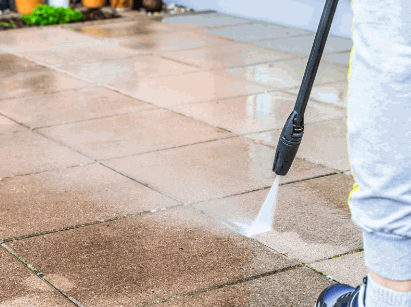
When Should a Patio Be Pressure Washed?
Regular maintenance is key to keeping a patio in top condition, and pressure washing should be done when outdoor areas show signs of dirt, stains, or grime buildup.
It’s essential to establish a routine for patio maintenance to prevent dirt and grime from becoming deeply embedded in the surface. High-traffic areas, such as the entrance or seating areas, are particularly susceptible to dirt accumulation.
Regular washing of these key areas will not only enhance the overall appearance but also prolong the lifespan of the patio materials. On top of that, keeping an eye out for signs like mold growth, discoloration, or slippery surfaces is a clear indication that it’s time for an outdoor washing session.
Factors to Consider Before Pressure Washing a Patio
Before pressure washing a patio, factors such as the presence of water, mold, mildew, and the type of patio items and concrete surfaces should be carefully considered to ensure an effective cleaning process.
Water on the patio can impact the pressure washing process, affecting the overall effectiveness of the cleaning. Mold and mildew buildup can pose challenges and may require specific cleaning solutions or techniques.
When dealing with different patio items, such as furniture or decorations, one must consider their material and durability to prevent damage during pressure washing.
The type of concrete surface also plays a crucial role – smooth surfaces may require less pressure, whereas textured surfaces might need more care to avoid etching or damage.
How to Pressure Wash a Patio?
Pressure washing a patio can be done through DIY cleanings or by hiring professional services, depending on the homeowner’s preferences and the level of patio investment. It is crucial to address algae and other growths during the cleaning process.
When opting for a DIY approach, start by clearing the patio of any furniture or obstacles. Next, ensure that any delicate plants nearby are protected from the pressure washer’s force.
If hiring a professional service, ensure that they use appropriate equipment and eco-friendly cleaning solutions to maintain the integrity of the patio surface.
Regular cleaning not only enhances the aesthetics of your patio but also prolongs its lifespan, ultimately preserving your valuable patio investment for years to come.
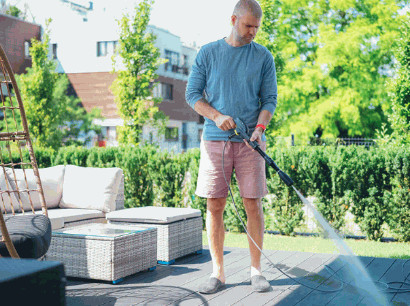
Step-by-Step Guide to Pressure Washing a Patio
A step-by-step guide to pressure washing a patio involves preparing the workspace, protecting furniture and plants, selecting the appropriate detergent, and executing a thorough cleaning process to ensure optimal results.
Before starting the pressure washing task, it is crucial to clear the patio area of any obstacles like furniture and potted plants to provide ample working space. Cover delicate items with waterproof tarps or move them to a safe distance to prevent any damage during the cleaning process. Next, choose the right detergent suitable for the surface material of the patio. It is essential to follow manufacturer instructions for mixing and dilution.
What Equipment is Needed for Pressure Washing a Patio?
Essential equipment for pressure washing a patio includes a power washer, water supply, trash bags for debris disposal, and protective gear to shield surfaces and surrounding areas during the cleaning process.
When diving into pressure washing a patio, having a reliable power washer is crucial to effectively remove the built-up grime and dirt. The water supply source, whether it’s from a standard hose or a portable water tank, aids in providing continuous water flow for the cleaning task at hand. Trash bags come in handy for collecting debris such as leaves, twigs, and other loose particles that accumulate during the cleaning process. Equally important is the protective gear like goggles, gloves, and boots to ensure safety and prevent any potential injuries from the high-pressure water stream or debris splatter.
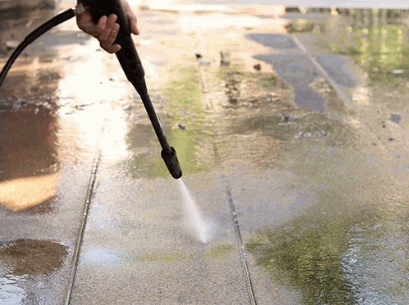
Types of Pressure Washers
Different types of pressure washers are available for patio cleaning, ranging from professional-grade machines utilized by services to homeowner-friendly models suitable for DIY pressure washing. Safety goggles should be worn to protect the eyes when operating these tools.
Professional-grade pressure washers are designed for heavy-duty use on various surfaces, providing high pressure and flow rates for effective cleaning results. These machines are often gas-powered and require more maintenance compared to electric models. On the other hand, homeowner-friendly pressure washers are typically electric and easier to use for occasional cleaning tasks in residential settings.
- When using a pressure washer, it is essential to consider the type of surface you are cleaning to select the appropriate machine and settings to avoid damage.
- Service providers often opt for heavier-duty pressure washers to efficiently clean large areas such as driveways or commercial properties.
Other Equipment Needed for Pressure Washing a Patio
Plus the pressure washer and other equipment required for patio pressure washing include plastic sheeting for surface protection, a broom for debris removal, a dispenser bottle for detergent application, and specific tools for addressing oil stains effectively.
Plastic sheeting plays a crucial role in safeguarding the surrounding areas from overspray during the pressure washing process. Utilizing a sturdy broom helps in prepping the surface by clearing away loose dirt and leaves before starting the pressure washing.
- Dispenser bottles are essential for distributing the cleaning solution evenly across the patio’s surface, ensuring a thorough cleaning process. Targeted tools such as oil stain removers are essential for tackling tough oil stains commonly found on driveways, effectively restoring the patio’s appearance.
Safety Precautions for Pressure Washing a Patio
Implementing safety precautions is crucial when pressure washing a patio, including following safety protocols, adjusting pressure levels according to the surfaces being cleaned, and ensuring proper washing techniques to prevent damage.
Regarding safety protocols, wearing protective gear such as goggles, gloves, and closed-toe shoes is essential to shield yourself from any debris or chemicals. Additionally, adjusting pressure levels based on the surface type is key. For example, high pressure may be suitable for hard surfaces like concrete, but lower pressure should be used for more delicate materials like wood or vinyl siding. Using the correct washing techniques such as starting from a distance to test the pressure, moving the wand in consistent motions, and avoiding spraying at direct angles can help protect your patio and other surrounding areas from potential harm.
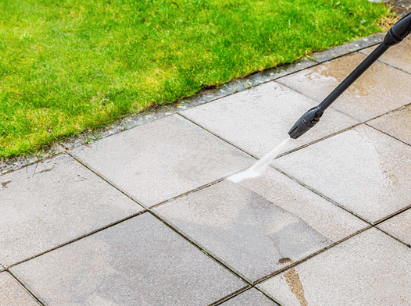
What to Do After Pressure Washing a Patio?
After pressure washing a patio, post-wash maintenance is crucial to ensure the longevity of the clean surfaces, addressing issues like algae regrowth on concrete or driveways.
One of the key tasks in post-wash maintenance is to regularly inspect the treated areas for any signs of algae regrowth, which can detract from the overall appearance of the surfaces.
Preventing algae regrowth involves applying an appropriate algae inhibitor or solution, and keeping the area clean and free from debris that could foster algae growth. Applying a protective sealant to concrete driveways after pressure washing helps to prolong the clean look and prevent future staining from oil or grease. This proactive approach to upkeep is essential in maintaining the pristine condition of your outdoor surfaces.
Post-Wash Maintenance Tips for a Patio
Post-wash maintenance for a patio involves collaborative efforts within the household, ensuring cleanliness and curb appeal, and may include applying sealants or consulting professional services like Steam Source for specialized cleaning needs.
Teamwork is crucial in maintaining the patio’s pristine condition as each member can contribute to the upkeep, from clearing debris to rearranging furniture for optimal aesthetics.
Enhancing curb appeal can be achieved by adding potted plants, outdoor rugs, or decorative lighting to create an inviting outdoor space.
Regular sweeping and hosing down the patio can prevent dirt buildup and maintain its polished look.
Professional cleaning services, such as Steam Source, can also provide deep cleaning solutions to tackle stubborn stains and grime that ordinary maintenance may not cover.

Conclusion: Is Pressure Washing Your Patio Worth It?
Pressure washing your patio is undoubtedly worth it, given the remarkable transformation in appearance, the removal of unsightly algae, and the time saved on manual cleaning processes.
The enhanced appearance of a freshly pressure-washed patio can truly uplift the entire outdoor space, creating a welcoming environment for relaxation and social gatherings. By eliminating stubborn algae growth, you not only improve the aesthetics but also prevent potential slips and falls, enhancing safety.
The efficiency gained through pressure washing significantly reduces the time and effort required to maintain your patio, allowing you to enjoy your outdoor space more frequently instead of being bogged down by tedious cleaning tasks.







